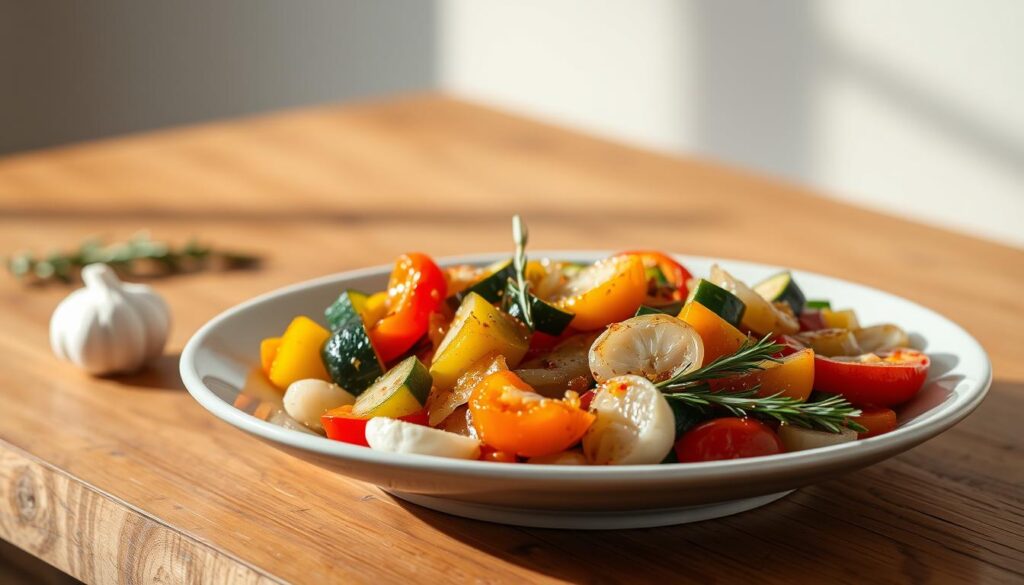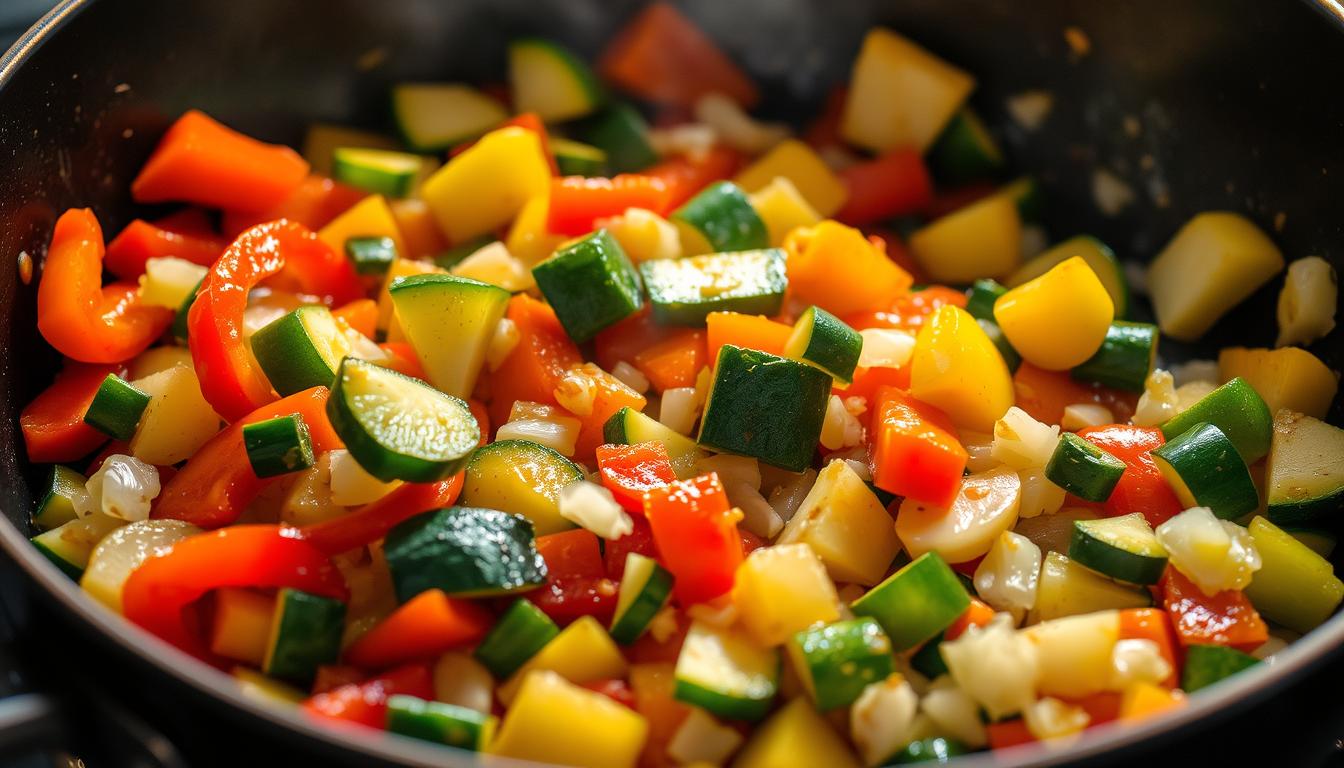Sautéed Vegetables With Pepper And Garlic
Imagine being able to prepare a flavorful and nutritious side dish in just a few minutes. Sautéed veggies with pepper and garlic can be that game-changer in your kitchen.
This simple yet vibrant dish is not only a perfect accompaniment to almost any meal, but it’s also a great way to incorporate more vegetables into your diet.
This easy-to-make recipe brings out the natural sweetness of the vegetables while maintaining their nutritional value. The key to this dish lies in the perfect balance of garlic and pepper flavors, making it a delicious addition to your weeknight dinners.
Key Takeaways
- Quick and easy preparation, ideal for weeknight dinners
- Customizable based on seasonal availability and personal preferences
- Rich in nutrients and flavors, making it a healthy side dish option
- Perfect balance of garlic and pepper flavors
- Versatile and complements almost any meal
The Perfect Sautéed Vegetables with Pepper and Garlic
A perfect blend of tender and crisp, sautéed vegetables with pepper and garlic is a treat for the taste buds. This dish is not only visually appealing but also packed with flavor, making it an ideal side dish for any meal.
The key to a perfect sautéed vegetable dish lies in achieving the ideal balance of tenderness and crispness. The combination of pepper and garlic creates a foundation of flavor that enhances rather than overwhelms the natural taste of the vegetables.
To achieve this, it’s crucial to manage the heat properly when sautéing vegetables. This ensures caramelization without burning, bringing out the best in the dish.
The colorful vegetables, such as bell peppers, carrots, zucchini, and yellow squash, add to the visual appeal of the sautéed vegetables.
Finishing the dish with butter or plant butter creates a silky sauce that coats the vegetables, adding to the overall flavor. This dish can be served immediately or prepared ahead of time, making it a convenient option for meal planning.
Ingredients You’ll Need
The key to a great sautéed vegetable dish lies in the quality of the ingredients you’ll be using. To make a delicious and flavorful dish, you’ll need to select the right vegetables, seasonings, and cooking fats.
Fresh Vegetables
For this recipe, you’ll need a variety of fresh vegetables. Some of the best options include zucchini, summer squash, bell peppers, and carrots.
These vegetables work well together because they have different textures and flavors, creating a harmonious balance in the dish. When selecting vegetables, look for firm texture and vibrant colors to ensure they’re fresh and ready to use.
- Choose firm and vibrant zucchini and summer squash for the best flavor.
- Select bell peppers with a glossy appearance and crunchy texture.
- Opt for carrots that are firm and have a bright orange color.
Seasonings and Aromatics
To add depth and flavor to your sautéed vegetables, you’ll need a selection of seasonings and aromatics. Garlic is a must-have, as it provides a pungent flavor that complements the vegetables.
You’ll also need salt to bring out the natural flavors of the vegetables. Other optional herbs like parsley or dill can add a fresh and bright note to the dish.
Cooking Fats
For sautéing, you’ll need a good quality oil like grapeseed or olive oil. You can also add a pat of plant butter towards the end of cooking to give the vegetables a rich and creamy flavor. Using a combination of oil and butter will enhance the overall flavor profile of the dish.
Kitchen Tools Required
To successfully sauté vegetables, you’ll need the right kitchen tools. A large, heavy-bottomed pan is essential for even heat distribution, which is crucial for cooking vegetables to perfection.
A non-stick surface or well-seasoned cast iron pan works best for preventing vegetables from sticking, making the cooking process smoother. You’ll also need a lid that fits your pan to help steam vegetables when needed, reducing overall prep time.
- A sharp chef’s knife and sturdy cutting board for efficient vegetable preparation
- Measuring tools for precise seasoning and oil quantities
Having the right tools can significantly reduce prep time and improve cooking results. While specialized tools can be helpful, this recipe can be made with basic kitchen equipment most home cooks already own.
Preparation Steps
Before you start cooking, it’s essential to prepare your vegetables properly. This involves washing, cutting, and measuring ingredients to ensure a smooth cooking process.
Washing and Cutting Vegetables
Start by thoroughly washing all your vegetables, including zucchini, carrots, bell peppers, yellow squash, and green beans, to remove dirt and pesticide residues.
Cut them into uniform sizes, approximately 1-inch pieces, to ensure even cooking. For instance, julienne bell peppers, slice zucchini and yellow squash into half-moons, and cut carrots into thin rounds.
Firmer vegetables like carrots may need to be cut smaller than softer ones like zucchini.
Measuring and Preparing Seasonings
Measure and prepare all your seasonings before cooking begins to streamline the process. Properly mince garlic to release its flavors effectively.
You can wash and cut vegetables up to 24 hours in advance to save time on busy weeknights. Proper preparation is key to achieving the best results in your final dish.
Step-by-Step Cooking Instructions
Mastering the technique of sautéing vegetables requires attention to detail and a step-by-step approach. To start, you’ll need to heat the oil in a large, non-stick pan over medium-high heat. This initial step is crucial for achieving the perfect sauté.
Starting with Firmer Vegetables
Begin by adding firmer veggies like carrots to the hot oil and cook for about 3 minutes. This initial cooking phase is essential to ensure that these harder vegetables are partially cooked before adding other ingredients.
Adding Remaining Vegetables and Seasonings
Next, add the remaining veggies, including zucchini, summer squash, and bell peppers, along with dry seasonings like salt, pepper, and optional herbs such as oregano and paprika.
Stir everything well, reduce the heat to medium, and cook covered with a lid for about 5-7 minutes, stirring occasionally.
Finishing with Butter and Herbs
Finally, turn off the heat and place plant butter on top of the veggies. Cover with a lid again and allow the butter to melt. Then, add fresh herbs and minced garlic, stirring everything well to combine.
This final step enhances the flavor and aroma of your sautéed vegetables, perfectly seasoned with pepper and garlic.
Pro Tips for Perfect Sautéed Vegetables
Sautéing vegetables to perfection requires a combination of technique and ingredient quality. To start, selecting the right vegetables is crucial.
Vegetable Selection and Cutting Techniques
Choosing good quality vegetables is essential. Opt for unblemished, firm-skinned veggies that are ripe and unbruised. Cutting the vegetables to similar sizes ensures they cook at the same speed, preventing some from burning while others remain raw.
- Select veggies based on firmness, color, and seasonal availability.
- Use advanced cutting techniques to enhance both appearance and cooking properties.
Cooking Techniques for Best Results
Proper heat management is key throughout the cooking process. Start with high heat for caramelization, then reduce heat as needed. Techniques like deglazing the pan with a small amount of water or broth capture all the flavor from the bottom.
- Deglaze the pan to capture all the flavor.
- Adjust cooking time based on the age and freshness of your veggies.

Variations and Substitutions
Sautéed vegetables are a canvas waiting for your creative touch. You can easily modify this dish to suit your taste preferences or dietary needs.
Alternative Vegetables
You can substitute other vegetables in this recipe. Broccoli and cauliflower are great alternatives, while green beans and cabbage add a nice crunch. Adjust cooking times based on the vegetable’s texture and water content.
Different Seasonings and Herbs
Experiment with various seasonings and herbs to change the flavor profile. Try onion powder, curry powder, or turmeric for a unique taste. Add a spicy kick with cayenne pepper or red pepper flakes to give your recipes a boost.
Adding Protein
Transform this side dish into a main course by adding protein sources like tofu, tempeh, chickpeas, or quick-cooking meats. This makes the dish more filling and satisfying, creating a complete meal with vegetables and recipes at its core.
Nutritional Information and Benefits
With a mix of colorful vegetables, this recipe is a nutritional powerhouse. Per serving, it contains 97kcal, 8g of carbohydrates, 2g of protein, and 7g of fat, including 2g of saturated fat. The dish is also rich in fiber, with 3g per serving, supporting digestive health and satiety.
The vegetables in this recipe provide a range of vitamins and minerals, such as vitamin A from carrots and vitamin C from bell peppers. Sautéing helps preserve these nutrients, unlike boiling, which can leach them into water.
This recipe fits into various dietary patterns, including Mediterranean and plant-based diets, and can be adjusted by modifying the amount of oil or butter used.
Storage and Reheating Instructions
Proper storage is key to enjoying your sautéed veggies for days to come. Store leftovers in an airtight container in the refrigerator for up to 5 days.
To reheat, use the microwave or stovetop. Simply heat until warmed through, typically within a few minutes.
| Reheating Method | Time | Tips |
|---|---|---|
| Microwave | 1-2 minutes | Cover with a microwave-safe lid |
| Stovetop | 2-3 minutes | Use medium heat, stir occasionally |
You can incorporate leftover sautéed vegetables into new recipes like frittatas or pasta dishes, making meal prep efficient and reducing food waste.

Conclusion
By incorporating sautéed vegetables into your meal rotation, you’ll be adding a nutritious and delicious twist. This simple recipe can be adapted to use whatever veggies are in season or available in your kitchen, making it perfect for both weeknight meals and special occasions.
Feel free to experiment with your own variations based on personal preferences and dietary needs. Pair these sautéed vegetables with pepper and garlic with grilled proteins or hearty grains for a well-rounded meal. Share your experiences and variations of the recipe to make this versatile side dish your own.







